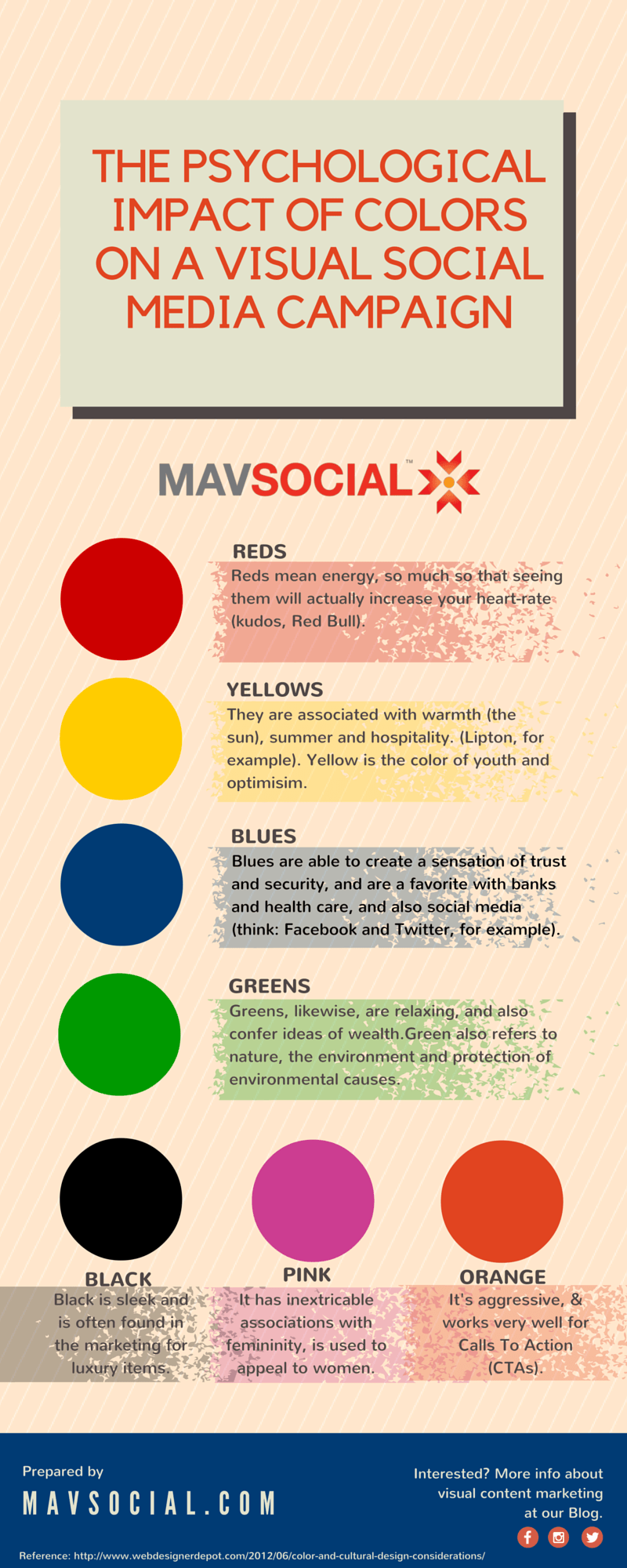A Simple Formula to Designing Captivating Visual Content
Images can be incredibly powerful, and the visuals that accompany your business proposition can really affect how your audience receives your message from your visual social media marketing campaign. After all, a picture tells a thousand words!
To give an extreme example, just think how hard it would be to market a gourmet restaurant if the only images you had at your disposal were of dirty dishes. Less extreme would be the same restaurant just having bland, boring and “me too” food and restaurant pictures. But, you’d be surprised, much more subtle nuances as opposed to crazy creativity – like the color choice, perspective, and layout – can really flavor your message too. So, to avoid giving off the wrong impression, you better know what you’re doing.
Making sure you place your message in the right visual context is the key to successful visual social media marketing.
However, like any creative process, deciding what counts as the right visual context is pretty subjective. Bear in mind another expression about images: a picture is viewed by a thousand different people in a thousand different ways – so trying to be too clever or too subtle with what you’re trying to convey could well be lost on most people in your audience: K.I.S.S. (Keep It Simple, Stupid!) is the mantra to follow when you’re in doubt.
ATTN DOM FANS: Get rewarded for your pizza eating habits. Start earning ?today: https://t.co/K9ecJJIwoo pic.twitter.com/nq8zuGr82m
— Domino’s Pizza (@dominos) December 18, 2015
This means that successful visual social media marketing campaigns depend very much on the talents and foresight of the marketer – get it right, and your image could go viral and generate tons of interest and sales; get it wrong, and it’ll either go unnoticed or, in a worst-case scenario, potentially damage your brand.
That said, there are some basic tenets of visual marketing that most successful campaigns adhere to. We’ve listed below the most important ones to make sure you get the visual marketing right.
1. Tit for Tat: Offer Your Customers Something Valuable
All human interactions can be viewed as a kind of trade. Picture this: if I cook a nice meal for you, then I would expect at least a “thank you” in return! I may even expect you to cook for me in the future, or (unless you got food poisoning, that is!) at least hope that you would. Failure to reciprocate or even acknowledge a favor severely reduces the chances of a similar favor being returned in the future.
This principle holds for visual marketing, too. Approaching visual marketing from this perspective can give you an advantage and make sense of your campaign’s effectiveness (or lack of it).
In all likelihood, you’re rolling out a visual social media marketing campaign because you want something from your audience – their details, their opinions, their engagement, their traffic, and eyeballs, etc. So think of the images you publish as a way of returning your audience’s generosity. Therefore, your visuals should aim to make your audience’s lives slightly better – perhaps with a clever witticism, calming image, or a piece of interesting information.
Don’t just bombard your audience with images designed explicitly to further your own interests, like the infamous and garish “Sale on Now” banner.
This isn’t to say that images like this don’t have a place – quite the opposite in fact because they are clear, concise and drive action from your audience. It is about frequency and timing: they should never make up the bulk of your visual social media marketing campaign as they will lose their impact.
2. Avoid Unnecessarily Detailed Images
The human eye takes in small chunks of information and processes them as images, before moving on to the next chunk. Even though it may feel as though you are taking in a large amount of information at once, you aren’t – your eyes are just moving incredibly quickly.
The upshot of this when it comes to visual marketing is to make sure you don’t attempt to cram too much information into a single image. It’s not easy, in fact, it’s nearly impossible, to look at a complicated visual and understand it immediately (just think of a map or complex graph). So try to eliminate any unnecessary elements wherever you can.

Remember, this only means that the image shouldn’t be complex. The message the image is supposed to convey can be as complex as you like. Indeed, the most evocative visuals are able to convey their meaning instantaneously, no matter how complex, layered, or multi-faceted they are.
This is where marketers should learn from Apple’s marketing – they convey extremely complex technology as being super-easy to use. Conversely, learn from the advertising and marketing of all razor blades – they position their very simple and age-old shaving devices as being ultra-complex in their attempts to convince you that you will have the closest, irritation-free and quickest shave possible! Again, it is about balance.
Check this post to explore 6 Imaginative, Engaging and Creative Social Media Campaigns.
3. Don’t Pick Your Colors Willy-Nilly in the Visual Social Media Marketing Campaign
One percent of shoppers are affected by sound and smell. Six percent of shoppers are affected by texture. Ninety-three percent of shoppers are affected by visual appearance! These are facts you just can’t ignore.
Colors have a psychological impact on all those that see them. So what do individual colors actually mean?
Yellows are associated with optimism and youth.
Reds mean energy, so much so that seeing them will actually increase your heart-rate (kudos, Red Bull). And in the Far East, confers ideas of prosperity and good luck.
Blues are able to create a sensation of trust and security, and are a favorite with banks and health care, and also social media (think: Facebook and Twitter, for example).
Greens, likewise, are relaxing, and also confer ideas of wealth.
Orange is aggressive, and as such works very well for Calls To Action (CTAs).
Pink, with its inextricable associations with femininity, is almost exclusively used to appeal to women and young girls.
Black is sleek and is often found in the marketing campaigns for luxury items.
Purple can soothe, and is often used with beauty products.
Of course, this is only a brief overview. There is a lot of information on the psychology of colors available for free on the web, with many different explanations and useful advice, and any hopeful marketers would do well to do their reading.
4. Social Proof: The Importance of Engagement
Crowd mentality. It’s a bit of a cliché, but it’s true: people are far more likely to try something new if they can see other people doing it, even more so if those people are their friends.
This being the case, a percentage of the images you publish should be created with the express purpose of eliciting engagement – see, all of those images companies post that seem completely unrelated to their offering do serve a function!
Increasing engagement (so long as that engagement is positive) is tantamount to increasing credibility. If your image gets hundreds of “likes”, retweets, or shares, people unfamiliar with your brand are far more likely to want to find out more about what you do: no one likes to be left out of the loop.
When it comes to images designed to increase engagement, it’s important that they appeal to a wide audience. This is why quotes often work very well – people can relate to and identify with them, and feel the need to share that fact or statement with others.
But remember, though they may not be plugging your product or service, engagement-boosting images should still tie into your company’s values and philosophy. For example, if you sell sportswear, motivational quotes will work well; whereas if you’re a pet supplies store, pictures of cute animals may be more appropriate. And we all know how effective images of cute kittens and puppies are for any kind of marketing campaign!
5. Authority: Get It, Keep it
We typically trust doctors, senior executives, lawyers, and others who appear to have positions of extreme responsibility. And trust is very important when it comes to acquiring and keeping loyal customers.
In terms of your visual social media marketing campaign, the most effective and sustainable way to build trust is to publish original content. A lot of marketing content is copied, republished, or repurposed. But hackneyed old content is unlikely to win you any real fans.
If you can create something original that people won’t have seen before, that content is likely to build your reputation quickly and exponentially. The bad news is that it’s hard to come up with good original visuals. The worse news is that, in order to maintain your status as an “authority”, you’ll need to come up with good original content regularly.
There are a few tricks that can help get you started, such as exploring the 70 million free images we have in our image library. But when it comes down to it, the only way to be original is to spend time coming up with ideas, rejecting the bad ones, and refining the good ones. Master this, and you’ll be on to a winner.




